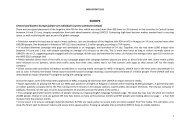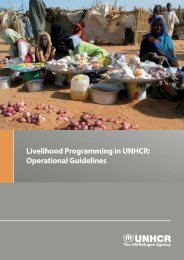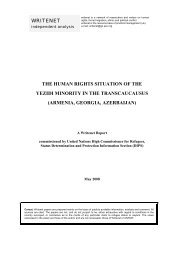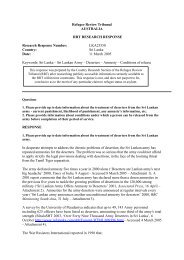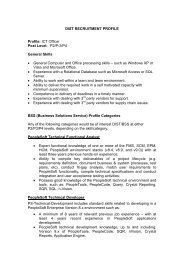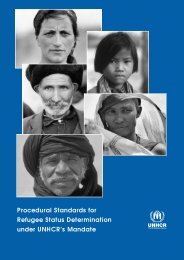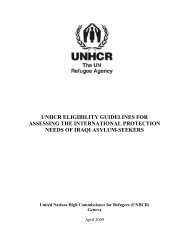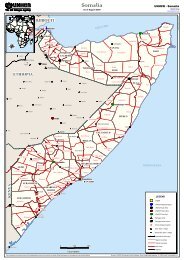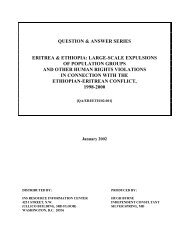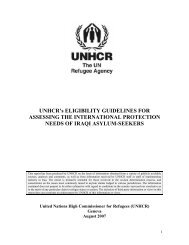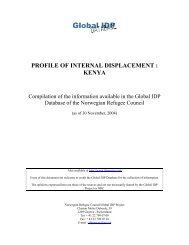CONCLUSIONS ADOPTED BY THE EXECUTIVE ... - UNHCR
CONCLUSIONS ADOPTED BY THE EXECUTIVE ... - UNHCR
CONCLUSIONS ADOPTED BY THE EXECUTIVE ... - UNHCR
Create successful ePaper yourself
Turn your PDF publications into a flip-book with our unique Google optimized e-Paper software.
2006 (Executive Committee—57 th Session)<br />
(n) Ensuring early identification and immediate response involves partnerships and actions to:<br />
(i) establish mechanisms, based on an analysis of the risk factors outlined above, to identify<br />
individual women and girls at risk, determine and implement appropriate immediate responses and<br />
subsequent solutions;<br />
(ii) provide women and girls at risk with information, counselling, medical and psychosocial care, as<br />
well as access to safe houses if they face domestic violence and abuse or attack by other members<br />
of the community, especially where there are no mechanisms to remove perpetrators; provide<br />
emergency voluntary relocation, e.g. to another town or camp, or emergency resettlement;<br />
(iii) determine the best interests of girls at risk, provide alternative accommodation, physical protection<br />
and interim foster care as required, as well as initiate family tracing and ensure family unity<br />
wherever possible and in their best interests; and<br />
(iv) ensure that refugee status determination procedures provide female asylum-seekers with effective<br />
access to gender-sensitive procedures and recognize that gender-related forms of persecution in the<br />
context of Article 1A (2) of the 1951 Convention relating to the Status of Refugees may constitute<br />
grounds for refugee status.<br />
(o) Developing medium-term responses for individuals includes partnerships and actions to:<br />
(i) monitor on an ongoing basis initiatives taken with regard to individual safety, well-being and<br />
needs and ensure accountability for actions taken;<br />
(ii) help secure the access of women and girls at risk to justice and reduce impunity, including by<br />
advising, accompanying and supporting them through initiatives such as women's legal clinics,<br />
local women's associations, witness relocation programmes and mobile courts in remote areas; and<br />
(iii) strengthen identified individuals' access to education, vocational training and recreational<br />
programmes with childcare and promote community-based livelihood strategies which target<br />
women and girls at risk, especially in prolonged displacement situations.<br />
(p) Recommended longer-term responses and solutions include partnerships and actions to:<br />
(i) promote respect for women's and girls' equal rights to make a free and informed choice to return<br />
voluntarily and to their equal access to land and property in the country of origin, and incorporate<br />
measures to ensure adequate ongoing assistance and support in the country of origin for those at<br />
risk into tripartite voluntary repatriation agreements;<br />
(ii) strengthen the use of resettlement as a protection and durable solutions tool for refugee women and<br />
girls at risk; enhance identification of refugee women and girls at risk for resettlement, including<br />
through training; streamline processing further, including by establishing measures to enable the<br />
speedier departure of refugee women at risk and their dependants;<br />
(iii) consider using special evacuation programmes for internally displaced women and girls at risk, if<br />
necessary, given that resettlement is very rarely available to them;<br />
(iv) establish mechanisms, where voluntary repatriation for individual refugee women and girls at risk<br />
is not a safe option and resettlement is not available, to enable them, where appropriate, to<br />
integrate locally and safely in the country of asylum, including by examining possibilities for<br />
voluntary relocation elsewhere in the country; for internally displaced women and girls at risk,<br />
examine possibilities for allowing them to relocate elsewhere in their own country if they wish and<br />
if their safety cannot be ensured where they are; and<br />
(v) ensure support, such as medical and psychosocial care, is available to women and girls at risk to<br />
facilitate their recovery and integration, whether this be in the context of local integration, return,<br />
resettlement or other humanitarian programmes.<br />
(q) Efforts to ensure the progressive implementation of the above-mentioned mechanisms and standards can<br />
benefit greatly from partnerships and the development of relevant public policies, supported as appropriate by<br />
the international community.<br />
186




